2016 has been a strange, vibrant year for DC Comics. When last year’s DC You initiative, which brought unique and offbeat titles such as Prez, Omega Men, and Bat-Mite to the forefront of the line failed to translate into financial success, the company responded with DC Rebirth. This latter movement has largely proven to be a return to DC’s core characters and values, aiming to appeal to their enfranchised core audience rather than the world at large. The work has been good, but it’s also been safe.
Luckily, for readers who look down from the open doors of a plane at 30,000 feet and spit at the notion of a parachute, Umbrella Academy writer and former My Chemical Romance lead singer Gerard Way has created the Young Animal imprint at DC Comics. While all the series launched as part of the imprint are in continuity and are largely inspired by previously existing DC properties, the goal behind these projects is to experiment and reinvent the wheel. Do they succeed? That’s what the Comics Beat managing editor Alex Lu and entertainment editor Kyle Pinion are here to discuss. Book by book. Panel by panel.
Note: the review below contains **spoilers**. If you want a quick, spoiler-free buy/pass recommendation on the comics in question, check out the bottom of the article for our final verdict.
 Doom Patrol #1
Doom Patrol #1
Writer: Gerard Way
Artist: Nick Derington
Colorist: Tamra Bonvillain
Alex Lu: No matter what way you slice it, there’s a lot riding on DC Comics’ Young Animal line. While the DC Rebirth launch has been both a critical and financial success three months in, there’s no denying that most of the Rebirth books double down on the “classic” DC characters, themes, and stories core audiences have come to love over the years, which leaves many less enfranchised fans out in the cold. Luckily for them, Former My Chemical Romance frontman and The Umbrella Academy writer Gerard Way envisions Young Animal as the polar opposite of Rebirth. Even though the books in the line will exist within the continuity of the DC universe, the goal of these books is experimentation and risk. This week, Young Animal debuts with Doom Patrol #1, written by Way and drawn by artist Nick Derington. Breathe deep, folks, because this book is good. It’s very good.
There have been many incarnations of the Doom Patrol in the past, most famously the version envisioned by Grant Morrison and Richard Case, and all of them have been exceedingly different in many ways. However, no matter what changes the team goes through from series to series, Doom Patrol books are always marked by their dedication to the strange. In Way’s and Derington’s incarnation of the series, the story focuses on ace EMTs Casey Brinke and Sam Reynolds. They’re great at their jobs but are pulled into a world they don’t yet understand after a mysterious ambulance dispatcher named “Em” sends them to a street corner where they witness Cliff Steele aka Robot Man get hit by a truck after escaping the confines of a world inside a gyro.
As someone who often complains about the inaccessibility of modern Big Two comics, I greatly appreciated the way in which Way and Derington ease us into the strangeness of the Doom Patrol universe. Casey and Sam function as point of view characters who are just as surprised as we are when trashcans explode next to them and robots get run over by trucks. While certain moments in the story will be more entertaining to those who have read previous runs of Doom Patrol, there’s nothing in the story that requires investment in previous continuity to enjoy (the “What’s Going On with Niles Caulder?” page is a total non-sequitur regardless of your investment level).
As characters, both Sam and Casey inspire a lot of investment from the reader straightaway. In their own ways, both characters are outcasts. Sam is the more grounded of the pair, but the way he opens up to Casey about his wife leaving him and his teenage son for a cult tells us there is much more pain beneath the surface of his persona.
On the other hand, Casey is a cloud, floating through the world with wacky ideas that everyone almost seems too willing to accept. I like Casey as a character, but some moments with her in this first issue rang false. In particular, late in the story, a woman named Terry None bursts into Casey’s apartment, makes her roommate explode, and then decides to move in. Casey seemed shocked by her roommate’s death, but brushes it off as though it was just a regular Wednesday morning for her. It almost defies logic to believe that a character could be that disassociated from reality even if her prom date did turn into a pile of “Lavender Membrane.”
That said, even in spite of this uneven characterization, there’s a lot to love about Doom Patrol #1. Nick Derington and Tamra Bonvillain outdo themselves with this issue. Derington’s inking style is smooth and playful. It gives the work a “Saturday Morning Cartoon” feeling that plays to the zany nature of Way’s script. This feeling is heightened by Bonvillain’s colors which, even in the darkest moments of the story, are effervescent with an almost neon sheen.
Kyle, as the more established DC fan among us, how did Doom Patrol #1 fare for you? How do you feel about Casey Brinke? The return of Danny the Street and Cliff Steele? How about that crazy art style shift inside the world of the gyro?
Kyle Pinion: I think it’s funny you call this accessible. I’m not totally sure I agree. From the Niles Caulder moment to the universe that exists within the gyro, to the odd-ball characters that exist in a sort of heightened reality, I can see this book being a big turnoff for a lot of people that have a very strong preconceived notion about what a superhero comic should look like or people coming in cold who have no sense of who Danny The Street is, for example. But that doesn’t make it bad. I thoroughly enjoyed this first issue, but it’s a weird little comic.
Then again, if you’re buying Doom Patrol, weirdness is just par for the course, hopefully.
What’s pretty great about Young Animal is that it returns to the idea of what Vertigo once was, a haven for mature reader stories that play with the richness of the DC universe. As much as I love titles like The Invisibles and Scalped, the loss of the DCU mythology from that catalog was a big blow. There’s something magical to Delano Animal Man, and Millar Swamp Thing, and Millgan’s Shade the Changing Man, and what I like about Young Animal is that it’s basically that same ideal brought into the comic book storytelling conceits and interests of the 2010s. What Way is channeling here is two-fold; despite all his in-depth talk about this being a celebration of all iterations of the team (and it could still be), this first issue is very indebted to the Morrison/Case approach, particularly with the sort of absurdity of the world within an everyday object approach, and the cut-up take on the narrative (the opening flashes, Caulder, the mention of Danny and the role that character will play in the ongoing concerns of the plot, and the final pages particularly, which I feel have to be hinting at Flex Mentallo, who is joining the team soon). There’s a sense of elliptical method that Morrison has kind of made his stock in trade, and as Way has long been a disciple of his, that method being utilized on this book particularly is very appropriate.
But really, anybody can do a Morrison impression – good or bad – I could roll off a few names right now, but the real difference maker is, as you say Alex, in the presentation of its point of view character. I think Casey and Terry are where the sort-of Hernandez Bros. style characteristics of the title are coming into place. Casey is already kind of an odd character, who sticks out from the rest of the world in a way that isn’t totally off the mark from how Maggie is presented in Love and Rockets issues. While I don’t necessarily want to assume there’s romantic potential between her and Terry, the latter character has a very sort of ramshackle, anything goes quality that reminds me of Hopey Glass…at least based on the short amount of time we spend with her.
In short, Way is combining my two favorite things, Morrison-esque pop-art dynamics (down to the Velvet Underground/Andy Warhol inspired cover) and a very strong hint of Hernandez character beats as a throughline– the latter of which was an influence on a book like Matt Fraction’s and David Aja’s Hawkeye, which in turn inspired an entire of wave of comics that have provided a nice entree for a new readership. This title is primed to hit the sweet-spot of a lot readers, but I think despite this being a very good issue, Way does face one significant challenge: the potential for this title to feel too much like a love letter to Doom Patrol runs of the past. These aren’t well-known characters and that’s tough for me to admit because I adore them all greatly, but Way will need to establish the “whos and whats and whys” of this team in a way that doesn’t pull too much focus from his very intriguing lead protagonist.
Or maybe he doesn’t. There’s a ton of punk rock-infused energy here and perhaps there’s no need for it to conform to any kind of preconceived formula. It’s Young Animal, not Rebirth after all, and I’m enthused enough to see what kind of shape that animal takes.
Does that answer your questions? Oh, right, that art style shift was fun, and that’s probably the moment that sticks with me the most other than Terry None herself, whose song and dance is just the best.
Really, I think I’m failing a bit in that I haven’t talked about Derington and Bonvillain at all. Though it’s easy for them to get overshadowed given the high profile of their creative partner, they definitely should not be. Doom Patrol #1 is a gorgeous looking comic with really fun, lively art. As someone who is very much a chromatophile, it’s exhilarating to see a mainstream comic with this vivid a palette. Take the prelude the comic opens on and the ambulance ride that follows: both of them are swathed in pinks and purples. This is not exactly the approach of your bog-standard Aquaman comic. And given the aforementioned flexibility displayed by Derington and his unique approach to character design, he may very well be DC’s best artistic addition this year despite some stiff competition for that title.
I really dug this book, as you can tell, and I’m very enticed by what’s to come, not only for Doom Patrol, but the entire line. If it’s all this good and fairly daring, I think Young Animal is going to be everything DC has needed for some time. Alex, you’re the hardcore Way guy, so I’ll let you have the final word.
Alex: Shh. My teenage years are a secret.
For the most part, I agree with what you said, Kyle. Ultimately, the reason why I think Doom Patrol #1 is more accessible than, say, Batman #1 is that while the book feels indebted to DC books that came before it, it does not form its identity from them wholecloth. The introduction of characters like Casey, Sam, and Terry are key to its success because they are as young and fresh as the audience Way and Derington hope to attract with this title and the Young Animal line as whole. Will you entirely get everything that happens in Doom Patrol #1 if you haven’t read a Doom Patrol title before? No. But that’s okay, because Casey and company don’t really get it either. We’re all getting strapped into this wild ride together and, fingers crossed, it’s going to be a doozy.
Final Verdict: Buy!


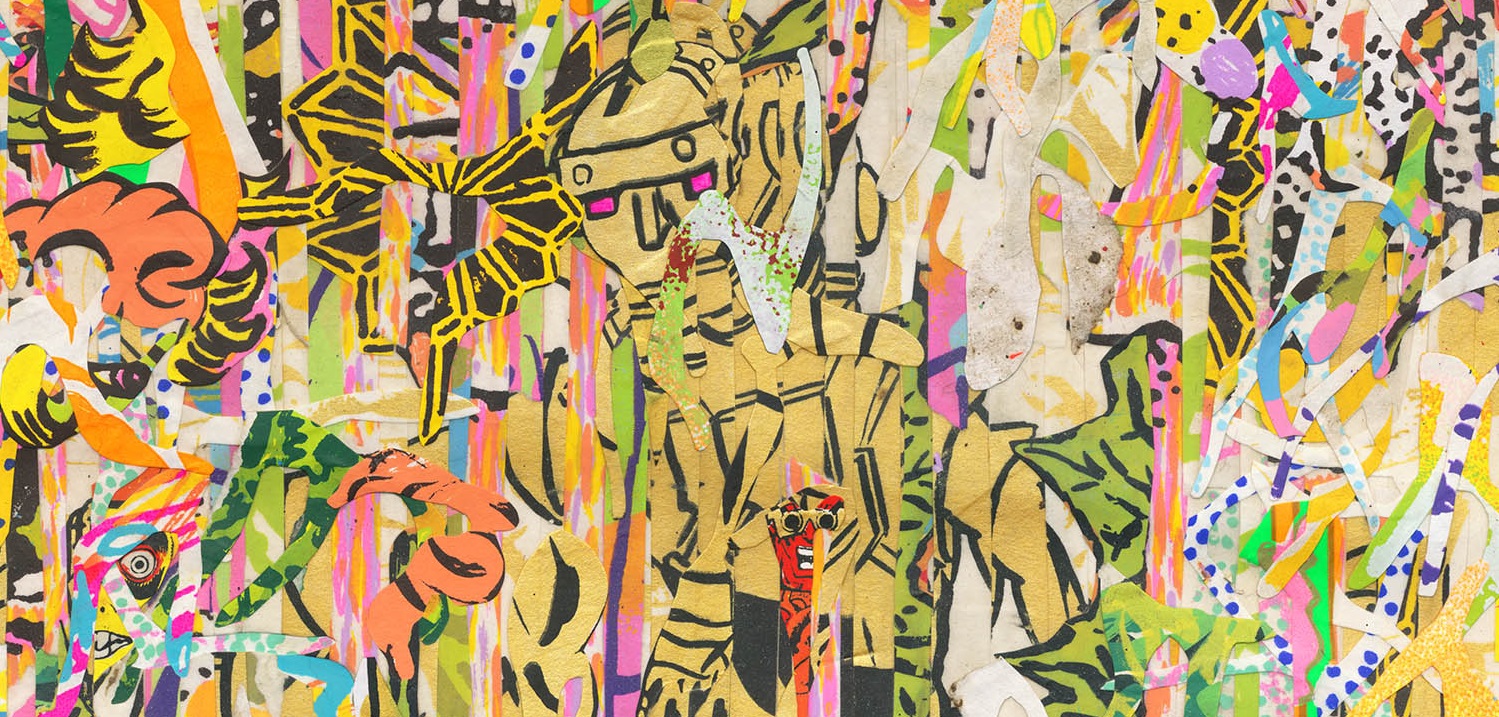
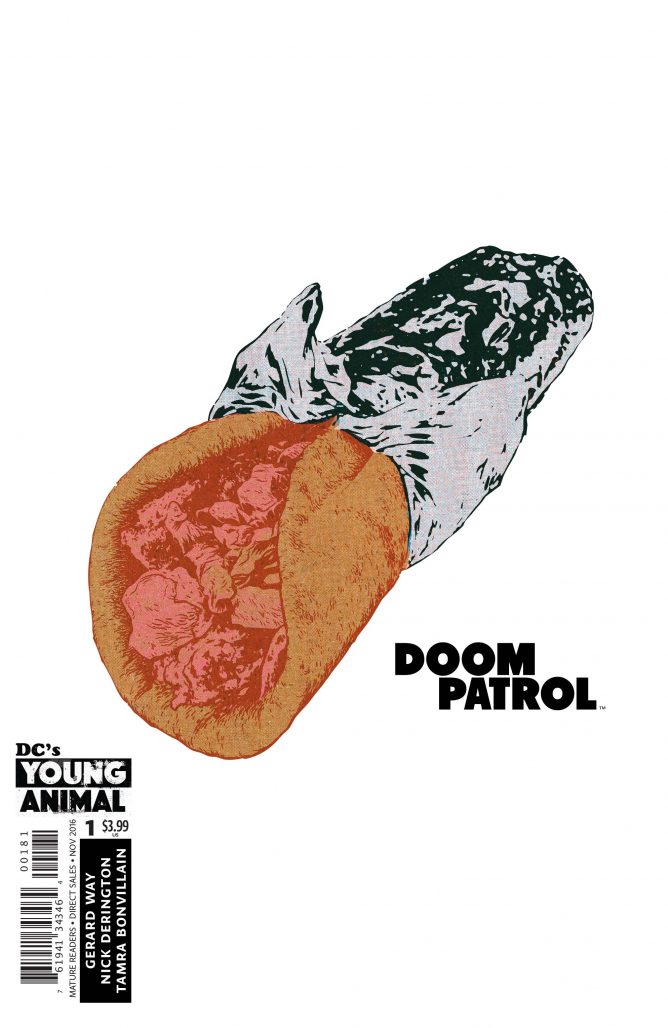 Doom Patrol #1
Doom Patrol #1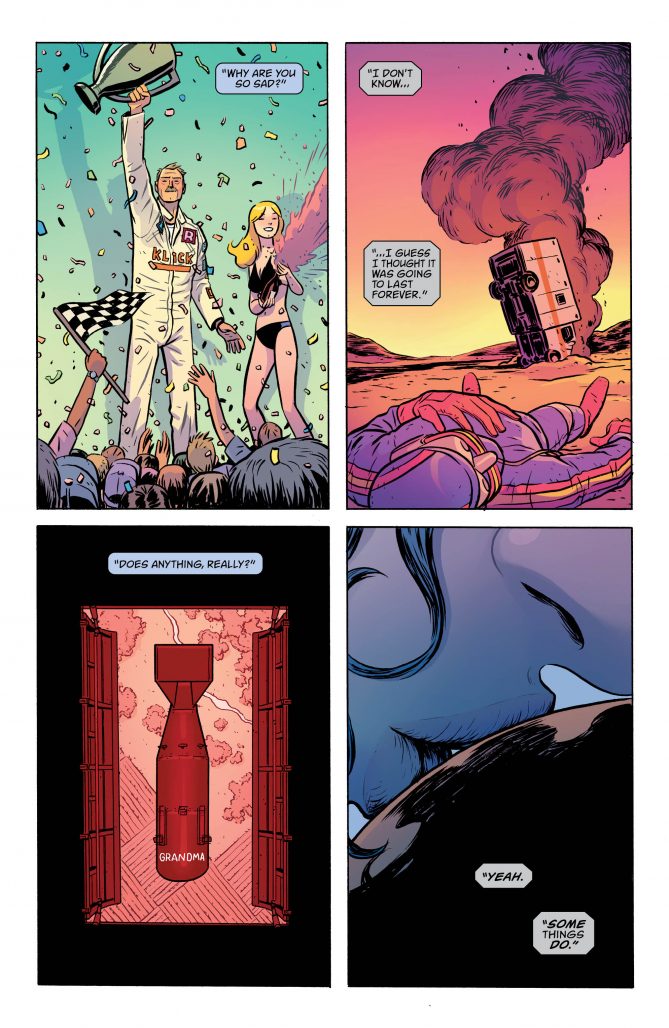
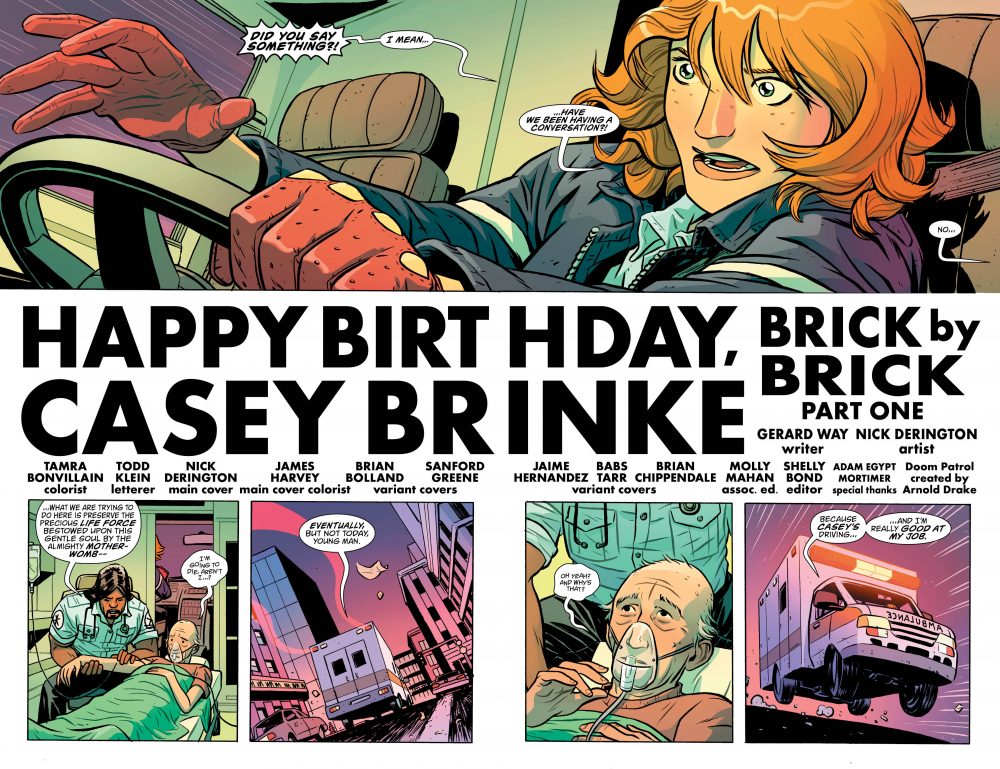
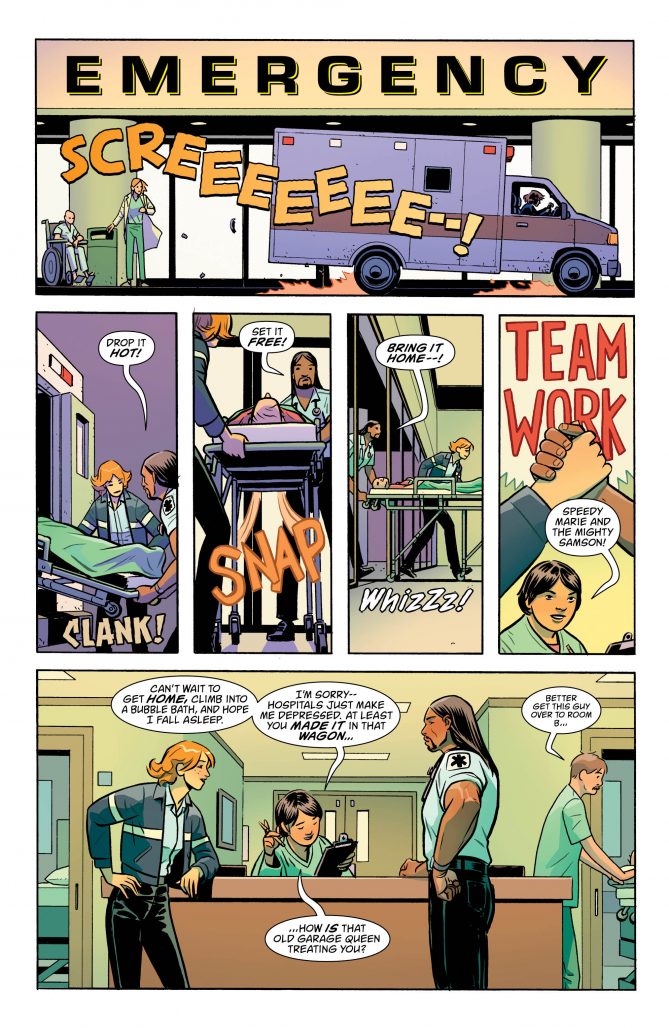
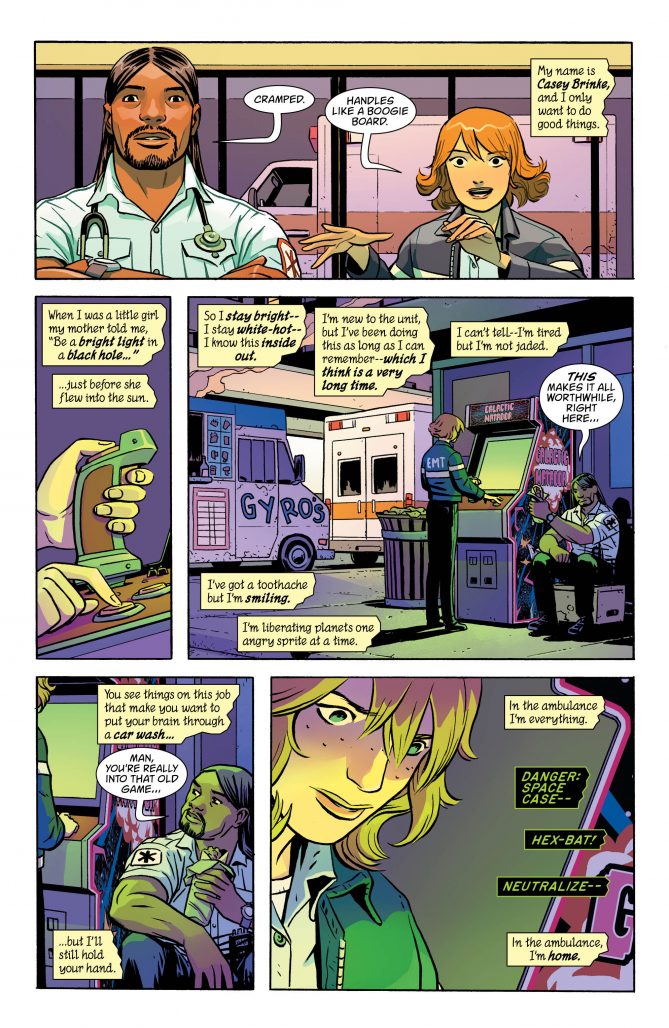
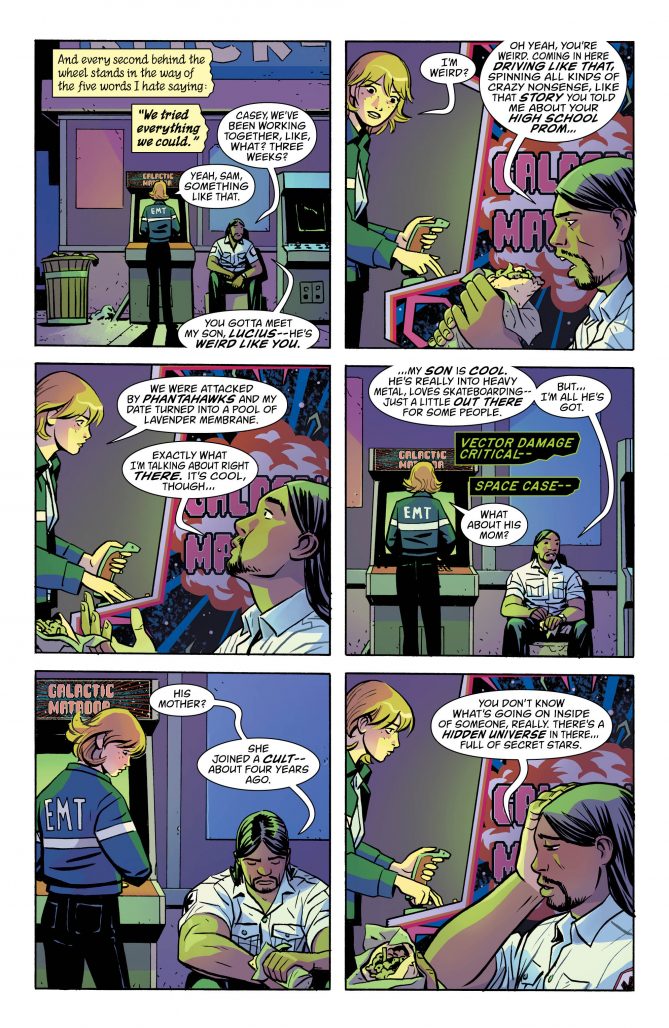
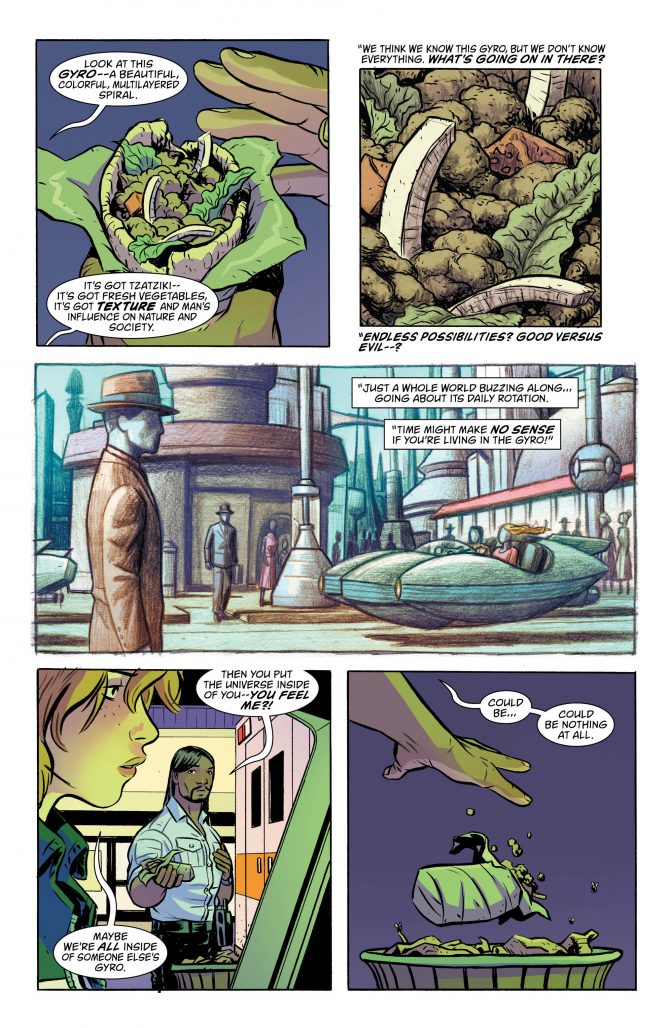






I thought the book was “good” but not “great”. There were several weirdness-for-weirdness’-sake moments that really detracted from my enjoyment; the Niles Caulder page (funny but…), the world in a gyro, and the exploding roommate (who I did not know was a roommate until it was spelled out several pages later – weak storytelling there!), for example.
It made me realize that I don’t think Doom Patrol has ever been “weird”. Sure, Morrison and Case had crazy aliens, and monsters, and ideas but they were never there as wacky non-sequiturs. This book is full of them to, I think, it’s detriment.
Solid dialogue in the human-moments, though.
Maybe it’s the nostalgia talking, but I remember the Morrison run as more cohesive than what we have here. He’d introduce something like the Brotherhood of Dada, then proceed from there along the well-grooved path of a superhero comic.
Here, we need faith in Way that he can tie the various snippets of strangeness together as he goes. The gyro connects to the aliens hunting Danny to the two brick scenes, probably. It’s more ambitious that what he tried in Umbrella Academy, and I hope he has the skill to pull it off.
Extra Credit: I liked the Niles Caulder page. Reminds me of the Babe the Blue Ox pages from Jack of Fables, which were the best part of the late run of that title.
Demerits: The lack of reaction to the exploding roommate; the shifts in Sam’s voice (mock-Kirby motherwombs to grounded contrast for Casey to universes inside gyros). Maybe both will make more sense in the context of more time with the characters.
Verdict: I’m in for the opening storyline. But this is no “Crawling from the Wreckage”.
Don’t blame Vertigo for losing the DC characters, it wasn’t their fault. Didio took them back when he launched the New 52. Vertigo were still publishing DC characters up ’til then – Madame Xanadu, Constantine/Hellblazer and the Unknown Soldier, for example.
I didn’t find Doom Patrol #1 accessible. It didn’t draw people in in the same way New Super-Man #3 did. OK, that’s a different book, different imprint. But if you want to pull in new readers, not people who’ve read Doom Patrols before like everyone here, it’s best to tell them what’s going on upfront. Cool art isn’t enough.
Comments are closed.